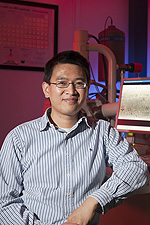Driving the magnet revolution for future accelerators
 |
|
Tengming Shen was awarded a DOE Early Career Award to develop a high-performance superconducting material for accelerator technology. Photo: Reidar Hahn |
Over the years, engineers have found ways to cram more and more transistors onto a single integrated circuit. As a result of these improvements, they have been able to pack more computing power into smaller machines.
In much the same way, the key to developing better high-energy particle accelerators has been building increasingly powerful magnets to put inside them.
The Department of Energy recently presented an Early Career Research Award to Fermilab scientist Tengming Shen, a 2010 Peoples Fellow working to spur the next magnet revolution.
DOE awarded Shen $500,000 per year for five years for his research into engineering high-field superconducting materials for advanced accelerator technology. If his team succeeds, the work could pave the way for the construction of high-field superconducting magnets for future accelerators such as Fermilab's proposed muon collider, for energy upgrades of the Large Hadron Collider and for the development of new medical imaging devices.
Shen's strategy is to search for a better magnet-making material. Scientists currently use two niobium-based materials, NbTi and Nb3Sn.
"You have to go into a territory that's new," he said.
Shen works with superconducting magnets, which conduct electricity without resistance when cooled below a certain temperature. This reduces the amount of energy required to power them and allows them to achieve higher magnetic fields.
To reach this point in his research, Shen has collaborated with other scientists in the Very High Field Superconducting Magnet Collaboration, a partnership among U.S. national laboratories, universities and members of superconductor industry.
Fermilab's Tevatron was the first particle accelerator to use niobium-titanium superconducting magnets. Before superconducting magnets, scientists had used iron or copper magnets, which required large amounts of electricity and, when used with insufficient cooling, tended to melt.
Fermilab founder Bob Wilson purchased as much niobium-titanium as he could, and Fermilab scientists developed a process for building large superconducting magnets. Members of industry eventually adopted the technology to mass-produce magnets used in MRI machines, now found in most hospitals. The major particle accelerators that have followed – the LHC at CERN, HERA at DESY and RHIC at Brookhaven National Laboratory – all depend on this technology.
Scientists cooled magnets in the Tevatron with liquid helium to 4.2 Kelvin; they reached a magnetic field strength of 4.3 Tesla. The scientists who built the Large Hadron Collider cooled their magnets with superfluid liquid helium to an even colder 1.9 Kelvin and almost doubled that performance to 8.3 Tesla. Fermilab and other U.S. laboratories have recently developed new technology using niobium-tin, Nb3Sn, which scientists hope will help them make the jump to 12- to 13-Tesla magnets.
The next step, according to Shen, is to push the limit of superconducting magnet technology by exploring new materials beyond the niobium family. This would allow scientists to more than double the energy reach of the LHC without increasing the size of the accelerator, he said.
Shen plans to study a group of high-field superconductors, in particular Bi2Sr2CaCu2Ox. He expects he could use this material to build magnets with a reach of up to 50 Tesla.
Even better, the new material could be used to construct 1- to 5-Tesla magnets that operate at higher temperatures. Whereas current superconducting magnets must be cooled with liquid helium, Shen's magnets could potentially be cooled with a simpler refrigeration unit.
"Helium is very expensive," Shen said. "There are many places like Africa, India and China that would like to develop cryogen-free devices."
The development of high-temperature superconductors could eventually lead to better power lines, faster computers and more energy-efficient transportation, Shen said.
"There are many superconducting materials and many more to be discovered," he said. "The whole world could be superconducting."
—Kathryn Grim
|